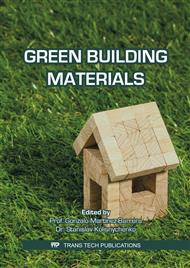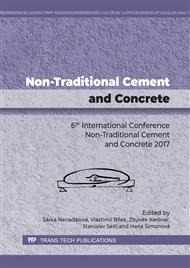[1]
P. B Bamforth, In situ measurement of the effect of partial Portland cement replacement using either fly ash or ground granulated blast furnace slag on the performance of mass concrete, Proc Inst Civ Engrs, 69(2) (1980) 777–800.
DOI: 10.1680/iicep.1980.2377
Google Scholar
[2]
B.B. Sabir, S. Wild, J. Bai, Metakaolin and calcined clays as pozzolans for concrete: a review, Cement and Concrete Composites 23 (2001) 441-454. .
DOI: 10.1016/s0958-9465(00)00092-5
Google Scholar
[3]
P. Duxson, J.L. Provis, G.C. Lukey, S.W. Mallicoat, W.M. Kriven, J.S.J. van Deventer, Understanding the relationship between geopolymer composition, microstructure and mechanical properties, Colloids Surf. A 269 (1–3) (2005) 47–58.
DOI: 10.1016/j.colsurfa.2005.06.060
Google Scholar
[4]
J. Davidovits, Geopolymer Chemistry and Applications, fourth ed., Institute Geopolymer, Saint-Quentin, France (2015).
Google Scholar
[5]
K. Komnitsas, D. Zaharaki, Geopolymerisation: a review and prospects for the minerals industry, Miner. Eng. 20 (2007) 1261–1277.
DOI: 10.1016/j.mineng.2007.07.011
Google Scholar
[6]
Z. Zhang, H. Wang, J.L. Provis, F. Bullen, A. Reid, Y. Zhu, Quantitative kinetic and structural analysis of geopolymers. Part 1. The activation of metakaolin with sodium hydroxide, Thermochim. Acta 539 (2012) 23–33.
DOI: 10.1016/j.tca.2012.03.021
Google Scholar
[7]
Z. Zhang, Y. Xiao, Z. Huajun, C. Yue, Role of water in the synthesis of calcined kaolin-based geopolymer, Appl Clay Sci 43(2) (2009) 218–223.
DOI: 10.1016/j.clay.2008.09.003
Google Scholar
[8]
L. Tong, M. Tang, Expansion mechanism of alkali-dolomite and alkali-magnesite reaction, Cem Concr Compos 21 (1999) 361–73.
DOI: 10.1016/s0958-9465(99)00022-0
Google Scholar
[9]
D. Matesova, D. Bonen, S.P. Shah, Factors affecting the resistance of cementitious materials at high temperatures and medium.
Google Scholar
heating rates, Materials and Structures 39 (2006) 455–469.
Google Scholar
[10]
C.K. Park, M.H. Noh, T.H. Park, Rheological properties of cementitious materials containing mineral admixtures, Cement and Concrete Research 35 (5) (2005) 842–849.
DOI: 10.1016/j.cemconres.2004.11.002
Google Scholar



